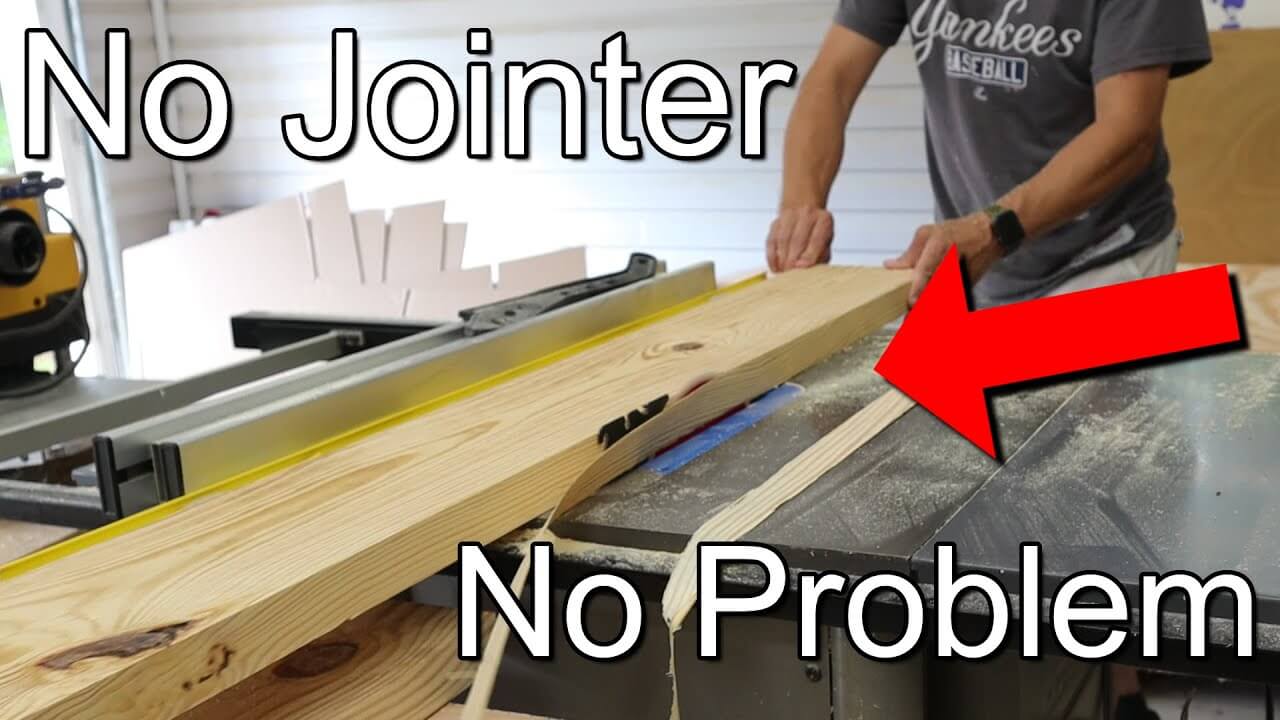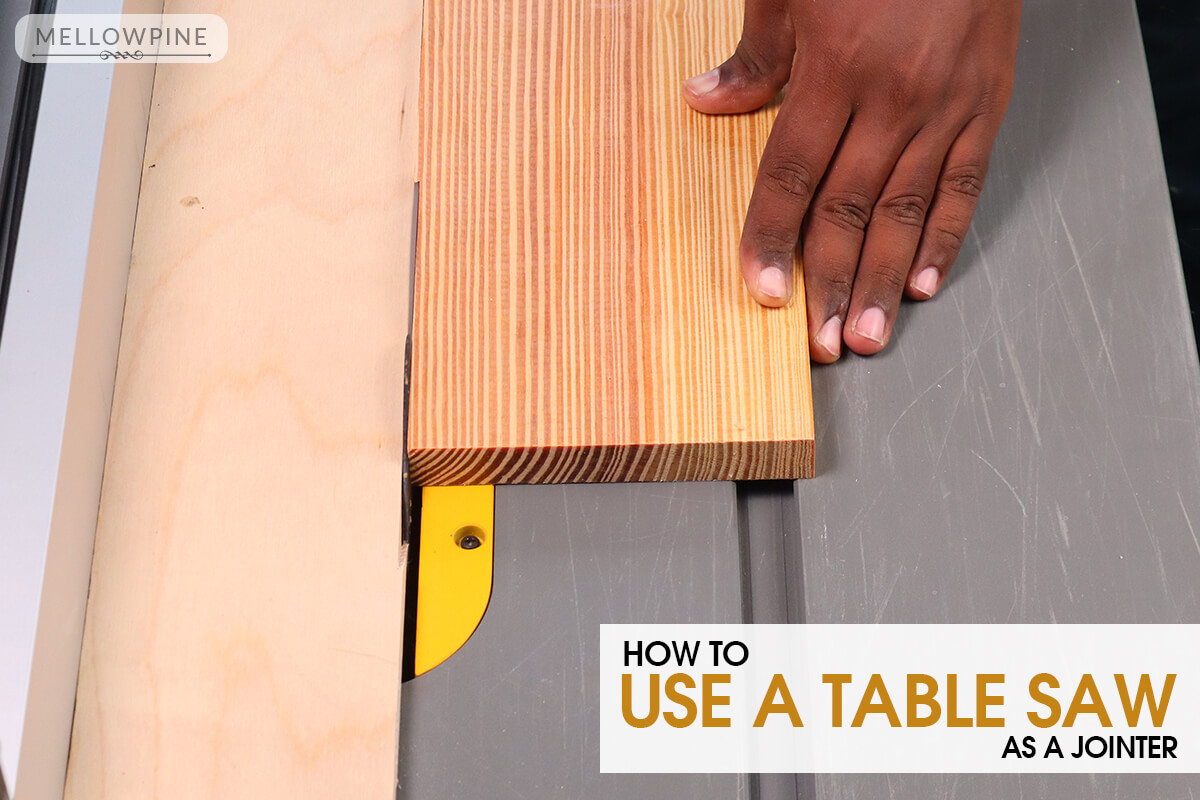When it comes to woodworking, having the right tools is essential. But do you need a jointer if you have a table saw? Let’s find out!
A jointer and a table saw may seem similar, but they serve different purposes in the woodworking world.
In this article, we’ll explore the functions of a jointer and a table saw, and whether or not you really need both in your workshop. Stick around to learn more!
Wondering if you really need a jointer when you already have a table saw? While both tools have their uses, they serve different purposes. A jointer is ideal for flattening and squaring edges, while a table saw is great for ripping and crosscutting. However, if your table saw has a jointing feature or if you’re primarily working with pre-surfaced wood, you may not need a dedicated jointer. Assess your specific woodworking needs to determine if a jointer would be beneficial for you.

Do You Need a Jointer if You Have a Table Saw?
In the world of woodworking, having the right tools can make all the difference in the quality and efficiency of your work. Two essential tools often found in a woodworker’s arsenal are the jointer and the table saw. While both are valuable in their own right, you may be wondering if you need both or if one can suffice for your needs. In this article, we will explore the benefits and functionalities of the jointer and the table saw, helping you determine if you need a jointer if you have a table saw.
The Purpose of a Jointer
A jointer is a woodworking tool designed specifically to flatten and square the edges of boards. It is used to create perfectly straight and smooth surfaces on one or more sides of a board, ensuring they can be joined together seamlessly. A typical jointer consists of a flat table, an infeed table, an outfeed table, a fence, and a rotating cutter head with multiple knives. When a board is fed through the jointer, the rotating knives remove small amounts of material from the uneven surface, resulting in a flat and squared edge.
One of the primary benefits of a jointer is its ability to create perfectly straight edges on boards. This is crucial for tasks like edge-to-edge glue-ups, where two or more boards are joined together to create a wider panel. Additionally, a jointer can also be used to flatten the face of a board, allowing for smoother and more accurate cuts on a table saw or other woodworking machines. In summary, a jointer excels at producing flat, square, and smooth surfaces on boards, making it an invaluable tool for any woodworker.
The Benefits of Using a Jointer
Using a jointer in conjunction with a table saw offers a range of benefits that can greatly enhance your woodworking projects:
1. Improved Precision:
A jointer ensures that the edges of your boards are perfectly straight and square, allowing for tight and accurate joints. This precision is crucial for tasks like creating furniture, cabinets, or any project that involves precise joinery.
2. Better Glue Joints:
When edges are perfectly flat and square, the resulting glue joints are stronger and more secure. This is especially important for projects that require strong and durable bonds, such as table tops or cabinet doors.
3. Enhanced Surface Quality:
A jointer creates a smooth and even surface on your boards, minimizing the need for extensive sanding and reducing the risk of tear-out when cutting on the table saw. This can save time and effort in the overall finishing process.
Do You Really Need a Jointer if You Have a Table Saw?
While a jointer offers distinct advantages, it is possible to achieve some jointing tasks using a table saw. Table saws equipped with sleds or specialized jigs can be used to straighten and square the edges of boards, albeit with some limitations. However, it’s important to note that a table saw cannot replicate the precision and surface quality produced by a dedicated jointer.
Using a Table Saw for Jointing Tasks
If you choose to use a table saw for jointing tasks, it’s essential to follow these tips to ensure the best results:
1. Use a Sled or a Dedicated Jig:
By using a sled or a specialized jig, you can guide your board through the table saw while keeping it perpendicular to the blade. This helps to achieve straight and square edges, albeit without the same level of precision as a jointer.
2. Plan for Some Extra Material:
When jointing on a table saw, you’ll likely remove more material than on a jointer. To compensate for this, make sure your boards are slightly wider than the required final width. This allows you to remove any imperfections or unevenness during the jointing process.
3. Consider an Auxiliary Fence:
Using an auxiliary fence on your table saw can help guide your boards more securely and maintain a consistent angle during the jointing process. This can result in improved accuracy and minimize the risk of kickback.
4. Perform a Cleanup Pass:
After jointing your boards on a table saw, it’s advisable to make a cleanup pass using a jointer or a hand plane to achieve smoother and more precise surfaces. This step helps eliminate any remaining imperfections and ensures a better overall result.
In Summary
While a table saw can be used for basic jointing tasks, it cannot replace the precision and quality provided by a dedicated jointer. If you are serious about woodworking and frequently work with rough and uneven boards, investing in a jointer is highly recommended. However, if budget or space constraints are a concern, you can utilize a table saw with the tips mentioned to achieve satisfactory results for smaller projects. Ultimately, the decision will depend on your specific needs and goals as a woodworker.
Key Takeaways: Do You Need a Jointer if You Have a Table Saw?
- A jointer and a table saw serve different purposes in woodworking.
- A jointer is used to flatten and straighten lumber edges.
- A table saw is used primarily for making straight cuts.
- If you don’t have a jointer, you can use a table saw with certain techniques to achieve similar results.
- Combining the use of both tools can result in even better woodworking outcomes.
Frequently Asked Questions
When it comes to woodworking, having the right tools can make a big difference. One common question that arises is whether or not you need a jointer if you already have a table saw. Here are some frequently asked questions that can help clarify the situation.
1. Can a table saw replace a jointer?
While a table saw and a jointer serve different purposes, in some cases, a table saw can be used to perform tasks that would typically be done on a jointer. For example, a table saw with a sled or a straight-line jig can be used to straighten and flatten boards. However, it’s important to note that a jointer is specifically designed for this purpose and may offer more precision and efficiency.
If you frequently work with rough lumber or need a high level of accuracy, a jointer is still a valuable addition to your woodworking arsenal. It can remove twists, make edges perfectly straight, and create precise joinery, tasks that a table saw is not designed to handle.
2. What are the advantages of using a jointer?
One of the main advantages of using a jointer is its ability to create perfectly flat and straight surfaces. This is crucial for tasks such as edge joining, where two boards need to be glued together smoothly. A jointer can also help in removing imperfections, such as bumps or snipes, and achieve a smoother finish.
A jointer also allows you to create precise joinery, such as rabbets, dadoes, and bevels, which are essential for various woodworking projects. Additionally, it can be used to square up rough lumber, making it easier to work with and yielding better results in the final project.
3. Can a table saw and a jointer be used together?
Absolutely! In fact, many woodworkers use a table saw and a jointer in tandem to achieve the best results. While the jointer can flatten and straighten boards, the table saw can then be used to make precise cuts and create various shapes and profiles.
Using both tools together allows you to maximize efficiency and accuracy. It’s important to note that each tool has its own unique functions and should be used accordingly. The jointer is perfect for preparing stock, while the table saw excels in making cuts.
4. Can a jointer replace a table saw?
No, a jointer cannot replace a table saw. While a jointer is designed for flattening, straightening, and creating precise edges, it cannot make the types of cuts that a table saw can. A table saw is essential for making crosscuts, rip cuts, miter cuts, and various angles.
Both tools have their specific functions, and it’s recommended to have both in your woodworking shop to have a well-rounded set of capabilities. The jointer is useful for surface preparation, while the table saw is crucial for shaping and cutting the wood.
5. Can I skip using a jointer if I have a thickness planer?
While a thickness planer can also be used to flatten and smooth surfaces, it’s not a direct replacement for a jointer. A thickness planer is primarily designed to ensure consistent thickness across a piece of wood and remove material evenly. It is not as effective in correcting twists, bowing, or creating precise edges like a jointer can.
Using both tools together can yield the best results. If you don’t have a jointer, you can still use a thickness planer to achieve a flat surface, but keep in mind that it may require additional techniques or jigs to achieve the same level of precision as a jointer.

NO JIGS! -Turn a table saw into a jointer to straighten boards!
Summary
So, do you really need a jointer if you already have a table saw? It depends on what you’re trying to achieve. Both tools have their own unique functions. A jointer is great for flattening and straightening edges, while a table saw is perfect for making precise cuts. If you only need to cut wood, a table saw might be enough. But if you want smooth and flat edges, a jointer will come in handy.
However, keep in mind that having both tools can greatly enhance your woodworking capabilities. A jointer and a table saw work together harmoniously, allowing you to create even more professional-grade projects. So, while you may not absolutely need a jointer if you have a table saw, it’s certainly worth considering adding it to your workshop for a more versatile and efficient woodworking experience.
